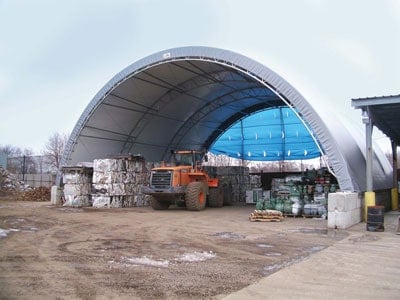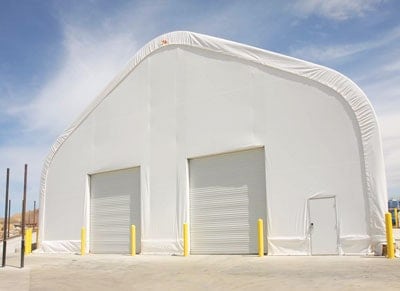With versatile and adaptable building solutions, such as fabric structures, businesses will prosper well into the future without the limitations a traditional building would impose.
By Nicole Pulyado
With environmental concerns in mind, communities often strive to reduce their waste output and create a greener, more sustainable future. However, reducing the garbage in landfills results in more recyclable materials for facilities to sort and process, requiring constant site growth to accommodate the ever-increasing and changing amount of waste. There is no shortage of business for waste management and recycling facilities, and their constant need to adapt makes for a difficult business model. Thankfully, there are versatile and sustainable solutions, such as fabric structures, that can be customized to change with facility needs over time.
Endless Applications
Fabric structures are the versatile building solution waste and recycling facilities need due to their many uses. Processing sites often have many operations and moving parts happening at any given time, and all of them can benefit from reliable building coverage.
Some of the most popular uses for fabric buildings are coverage for equipment and waste piles, sheltering operations such as sorting and weighing stations, and providing a covered area to protect employees from the outdoor elements as they work.
Perhaps the most useful part about fabric structures is that the application can be changed countless times over the years and adjusted to business needs at any given time. A waste facility may initially use their fabric building for equipment storage, keeping heavy duty machinery and trucks out of the elements to prevent damage. However, as time goes on there is always opportunity to remove a side wall for more open access and pivot to sheltering large waste piles. Fabric structures are a building solution that can adapt as business needs evolve.
Opportunity to Expand
Extra space found within fabric structures is the additional storage waste facilities desire. It is rare for a recycling and waste site to find that they have too much usable storage space, especially when there is always another pile of material on its way to being discarded. Luckily, fabric structures can be customized to individual business needs, creating a coverage solution tailored to each unique operation that includes room to grow.
Recycling facilities with fabric buildings understand the importance of an expandable structure. While it is expensive and inconvenient to add square footage onto traditional buildings, businesses can always double or triple the size of a fabric building later on by simply adding additional trusses to the length of the building. This expansion can happen efficiently, economically and within a short timeline, allowing businesses to grow immediately whenever they see fit.
Existing sites with traditional buildings are also a great candidate for fabric structures, because they blend seamlessly into any setting, making business and site expansion a painless process.
Customization
In addition to expansion, fabric structures are incredibly versatile in their design features. Ventilation systems are a common request when customizing fabric buildings, especially for waste facilities looking to mitigate unpleasant smells that can overwhelm surrounding communities. While fabric buildings naturally offer increased air flow with breathable fabric covers, there are additional custom options for increased ventilation, such as open side and end walls, large doors, extra tall clearances, industrial fans and HVAC systems. These solutions keep air circulating and alleviate many harsh smells that would otherwise become unbearable.
Building configuration is another opportunity for waste management operations to design the most efficient site possible. Fabric structures can often be designed to desired sizes and setups, creating expansive spaces with maximum usability. Sites can opt for one large structure to cover an entire business, a few mid-sized buildings to keep different operations separate, a singular small structure to enclose hazardous materials that need to remain isolated or any other arrangement they find beneficial. Even more importantly, they can make all these adjustments while maintaining a reasonable cost.
Businesses also have a wide variety of foundation options to choose from when designing a fabric building. Poured concrete, concrete blocks, wooden posts, shipping containers and helical anchors are just a few examples of foundation solutions that firmly secure structures to the ground. While poured concrete is an excellent solution for those in need of a permanent building, helical anchors, which drill directly into the ground with minimal site disturbance, are better suited for a business that may want to move the building to a different location. As with other building customizations, foundations offer the opportunity to tailor structures to specific site needs for maximum productivity.
Mobile Solutions
Fabric buildings become even more versatile with such a wide range of foundation options, because they become transportable and easily relocated. If a business opts for a temporary foundation solution, such as the helical anchoring system, they experience the benefits of both temporary and permanent buildings. While the structures maintain incredible durability, offering longevity and resilience in the most extreme weather conditions, they can also be moved to different places within a site or to entirely new locations. Just as helical anchors are drilled into the ground, they can also be undrilled when it comes time to relocate the structure, and there is no extensive excavation required.
Shipping containers are another foundation choice that offer incredible mobility for fabric building owners. The containers, which sit on top of a level surface, simply need to be picked up and transported to the next site. These innovative foundation solutions help businesses save time and money by retaining building investments.
In addition, many fabric buildings can be constructed on nearly any surface. Transporting buildings from one location to another does not include the hassle of finding that rare, perfect site, and business owners will not have to worry about purchasing a new property with existing buildings that do not work for their operation. Once a waste facility experiences increased efficiency with their customized fabric building, they are able to carry over that productivity to their new site by taking the structure with them.
Waste facilities that have found that their ideal building size, configuration and customizations are able to use their fabric structures throughout the life of their business, regardless of operational changes, site moves or expansions. With versatile and adaptable building solutions, such as fabric structures, businesses will prosper well into the future without the limitations a traditional building would impose. | WA
Case Study Snapshots:
The Importance of Versatility
Slesnick Iron & Metal
Slesnick Iron & Metal, a scrap metal sorting and recycling facility, understands the importance of building versatility for their operations. The company invested in three Hercules Truss Arch Buildings from ClearSpan Structures to update their business and keep materials properly sorted as they expanded. Tim Jones, Vice President of Operations, commented on the variety of uses he has found for the fabric buildings on the sorting and recycling site. “We like the spaciousness of the buildings, because it allows enough room to store several tons of metal, and the high clearances are tall enough to park a truck inside,” Jones said.

After finding the structures to hold even more than originally anticipated, Jones was able to find additional uses for the fabric buildings. “We are also using the buildings to keep equipment out of the weather. This has provided a place to perform maintenance on our heavy machinery, while also making their engines start up easier in the morning,” he continued.
Commodity Resource & Environmental
When Commodity Resource & Environmental, Inc. decided to grow the business by adding a secure document destruction facility, they integrated a 60-foot wide by 50-foot long ClearSpan fabric building into their existing site. “The document destruction department was a new operational venture. We needed an additional structure to house the equipment and serve as the facility,” said Larry DeWitt, President of Commodity Resource & Environmental, Inc.

Photos courtesy of ClearSpan Fabric Structures.
He continued by commenting on how cohesive the building has been for the waste site, stating, “The cosmetic and structural design of the building, both inside and out, has impressed both employees and visiting customers. It looks and works perfectly.”
Nicole Pulyado is a PR and Digital Content Specialist with ClearSpan Structures (South Windsor, CT), which specializes in building solutions for the waste and recycling industry. For more information, call (866) 643-1010 or e-mail [email protected].
You may also like:
The Importance of a Site-Specific Review for Fabric Structures
